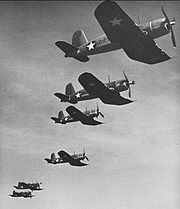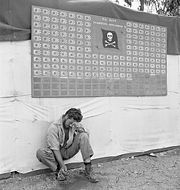
VF-61
Encyclopedia


United States Navy
The United States Navy is the naval warfare service branch of the United States Armed Forces and one of the seven uniformed services of the United States. The U.S. Navy is the largest in the world; its battle fleet tonnage is greater than that of the next 13 largest navies combined. The U.S...
until its disestablishment on on April 15, 1959.
Three U.S. Naval Aviation squadrons have used the name and insignia of the Jolly Roger
Jolly Roger
The Jolly Roger is any of various flags flown to identify a ship's crew as pirates. The flag most commonly identified as the Jolly Roger today is the skull and crossbones, a flag consisting of a human skull above two long bones set in an x-mark arrangement on a black field. This design was used by...
: VF-17/VF-5B/VF-61, VF-84
VF-84
VF-84, Fighter Squadron 84 was an aviation unit of the United States Navy active from 1955 to 1995. The squadron was nicknamed the Jolly Rogers and was based at NAS Oceana.-Related squadrons:Five distinct U.S...
(est. 1955), and VFA-103
VFA-103
Strike Fighter Squadron 103 , nicknamed the Jolly Rogers is an aviation unit of the United States Navy established in 1952. VFA-103 flies the F/A-18F Super Hornet and is based at Naval Air Station Oceana, Virginia...
.
The first incarnation of the Jolly Rogers was established on January 1, 1943 at NAS Norfolk, as VF-17 by Lieutenant Commander John T. "Tommy" Blackburn. It was the second Navy fighter squadron to receive the F4U-1 Corsair
F4U Corsair
The Vought F4U Corsair was a carrier-capable fighter aircraft that saw service primarily in World War II and the Korean War. Demand for the aircraft soon overwhelmed Vought's manufacturing capability, resulting in production by Goodyear and Brewster: Goodyear-built Corsairs were designated FG and...
and the most successful of them all.
Blackburn wanted a squadron insignia which would live up to the Corsair name; hence the skull and crossbones were chosen. The original design was developed by Harry Hollmeyer who became an ace pilot. The squadron helped during the development of the F4U Corsair resulting in some design changes, resulting in the F4U-1A. Unfortunately, the Navy still deemed the Corsair "unfit" for carrier service and instead of joining USS Bunker Hill
USS Bunker Hill (CV-17)
USS Bunker Hill was one of 24 s built during World War II for the United States Navy. The ship, the second US Navy ship to bear the name, was named for the Battle of Bunker Hill. Bunker Hill was commissioned in May 1943, and served in several campaigns in the Pacific Theater of Operations, earning...
, VF-17 became a land-based squadron in the Solomon Islands
Solomon Islands
Solomon Islands is a sovereign state in Oceania, east of Papua New Guinea, consisting of nearly one thousand islands. It covers a land mass of . The capital, Honiara, is located on the island of Guadalcanal...
during most of its deployment to the South Pacific.
On November 8, 1943, the squadron Executive Officer
Executive officer
An executive officer is generally a person responsible for running an organization, although the exact nature of the role varies depending on the organization.-Administrative law:...
, Roger Hedrick, led a flight which intercepted 39 Japanese fighters over Empress Augusta Bay
Empress Augusta Bay
Empress Augusta Bay is a major bay on the western side of the island of Bougainville, in Papua New Guinea, at . It is a major subsistence fishing area for the people of Bougainville. It is named after Augusta Viktoria of Schleswig-Holstein, wife of German Emperor William II.In November 1943, the...
, Bougainville
Bougainville Island
Bougainville Island is the main island of the Autonomous Region of Bougainville of Papua New Guinea. This region is also known as Bougainville Province or the North Solomons. The population of the province is 175,160 , which includes the adjacent island of Buka and assorted outlying islands...
. As the Japanese fighters fled back to their base, VF-17 was responsible for downing 3 fighters and damaging 4 others. Though outnumbered, the squadron survived the encounter with no losses. This action was typical of the squadron's land-based service in the Solomon Islands in 1943 and 1944, when it went up against the cream of Imperial Japanese Navy pilots then based at Rabaul.
In its two tours of duty in the Solomon Islands, VF-17 had 152 aerial victories and produced 11 aces. VF-17 finished its combat tour on May 10, 1944 and was equipped with the F6F-5 Hellcat
F6F Hellcat
The Grumman F6F Hellcat was a carrier-based fighter aircraft developed to replace the earlier F4F Wildcat in United States Navy service. Although the F6F resembled the Wildcat, it was a completely new design powered by a 2,000 hp Pratt & Whitney R-2800. Some tagged it as the "Wildcat's big...
moved to the USS Hornet
USS Hornet (CV-12)
USS Hornet is a United States Navy aircraft carrier of the Essex class. Construction started in August 1942; she was originally named , but was renamed in honor of the , which was lost in October 1942, becoming the eighth ship to bear the name.Hornet was commissioned in November 1943, and after...
. The squadron amassed 161 victories, and produced 12 aces. Overall, the two combat tours of VF-17 were credited with 313 victories, the most of any US Navy squadron. VF-17 was redesignated as VF-5B in 1946, and as VF-61 in 1948. In addition to the F4U-4 Corsair and F6F-5P Hellcat, it flew the F8F-2 Bearcat
F8F Bearcat
The Grumman F8F Bearcat was an American single-engine naval fighter aircraft of the 1940s. It went on to serve into the mid-20th century in the United States Navy and other air forces, and would be the company's final piston engined fighter aircraft...
, F9F-2 Panther and the F9F-8 Cougar
F9F Panther
|-Popular culture:The Panther played a prominent role in the 1954 movie Men of the Fighting Lady . The F9F was featured in the flying sequences in the 1954 movie The Bridges at Toko-Ri, although in the 1953 James A...
. It was disestablished on April 15, 1959.

